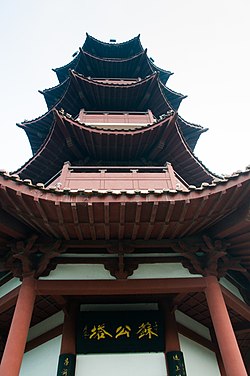Xuzhou
|
Xuzhou 徐州市 |
|
|---|---|
| Prefecture-level city | |

The skyline of Xuzhou and Yunlong Lake (云龙湖)
|
|
 Location of Xuzhou City jurisdiction in Jiangsu |
|
| Location in China | |
| Coordinates: 34°16′N 117°13′E / 34.26°N 117.21°ECoordinates: 34°16′N 117°13′E / 34.26°N 117.21°E | |
| Country | China |
| Province | Jiangsu |
| County-level divisions | 10 |
| Township-level divisions | 161 |
| Government | |
| • Mayor | Zhou Tiegen (周铁根) |
| • CPC Committee Secretary | Zhang Guohua (张国华) |
| Area | |
| • Prefecture-level city | 11,259 km2 (4,347 sq mi) |
| • Urban | 3,037 km2 (1,173 sq mi) |
| • Metro | 2,347 km2 (906 sq mi) |
| Population (2010 census) | |
| • Prefecture-level city | 8,577,225 |
| • Density | 760/km2 (2,000/sq mi) |
| • Urban | 3,053,778 |
| • Urban density | 1,000/km2 (2,600/sq mi) |
| • Metro | 2,623,066 |
| • Metro density | 1,100/km2 (2,900/sq mi) |
| Time zone | China Standard (UTC+8) |
| Postal code | 221000(Urban center), 221000, 221000, 221000(Other areas) |
| Area code(s) | 0516 |
| GDP | ¥ 532 billion (2015) |
| GDP per capita | ¥ 62,000 (2015) |
| Major Nationalities | Han |
| Licence plate prefixes | 苏C |
| Website | xz |
| Xuzhou | |||||||||

"Xuzhou", as written in Chinese
|
|||||||||
| Chinese | 徐州 | ||||||||
|---|---|---|---|---|---|---|---|---|---|
| Postal | Suchow | ||||||||
|
|||||||||
| Pengcheng | |||||||||
| Chinese | 彭城 | ||||||||
|
|||||||||
| Transcriptions | |
|---|---|
| Standard Mandarin | |
| Hanyu Pinyin | Xúzhōu |
| Wade–Giles | Hsu2-chou1 |
| Transcriptions | |
|---|---|
| Standard Mandarin | |
| Hanyu Pinyin | Péngchéng |
Xuzhou, known as Pengcheng in ancient times, is a major city in and the fourth largest prefecture-level city of Jiangsu Province, China. Its population was 8,577,225 at the 2010 census whom 2,623,066 lived in the built-up (or metro) area made of Quanshan, Gulou, Yunlong and Tongshan districts. It is known for its role as a transportation hub in northwestern Jiangsu, as it has expressways and railway links connecting directly to the provinces of Henan and Shandong, the neighboring port city of Lianyungang, as well as the economic hub Shanghai.
Before the adoption of Hanyu Pinyin, the city's name was typically romanized as Suchow or Süchow, though it also appeared as Siu Tcheou [Fou], Hsu-chou, Hsuchow, and Hsü-chow.
Several Neolithic remains were discovered in Xuzhou. During 1960s and 1970s, the discovery at Dadunzi site in Sihu, Pizhou, whose relics, especially some painted potteries strongly prove the area belonged to Dawenkou culture (c. 4100–c. 2600 BC). Besides, Gaohuangmiao site, Tongshan and Liulin site, Pizhou were also important contemporary remains.
In the end of 1950s, remains of sacrificial activities to the God of Land at the Qiuwan site in Maocun, Tongshan was discovered. The archaeologists inferred that the remains date back to the Shang dynasty and they belong to Peng or Great Peng. Peng was once a chiefdom dominated the partial area of Xuzhou nowadays, which eventually conquered by King Wu Ding of Shang in around 1208 BC.Peng Zu, a legendary long-lived figure, is believed to be the first chief. Pengcheng, the ancient name of Xuzhou, was origins from the state of Peng, the word "cheng" means "city" in Chinese. Thus "Pengcheng" is "the city of Peng" or "Peng city" literally.
During the Western Zhou, the people who were resident in the Huai River valley, northern Jiangsu and northern Anhui today, were two chiefdoms called Xuyi and Huaiyi at that time. Despite the relation between them and their origins are not quite clear for historians, there is no doubt that they were great threaten to the ancient states around them. Xuyi, namely Xu, made an alliance with Huaiyi, they battled with Zhou's troop at irregular intervals, and the realm of Xu varied constantly. Since the original territory was occupied by Lu, people of Xu migrated to the southern, while the capital at one time moved to the area of Xuzhou.
...
Wikipedia

